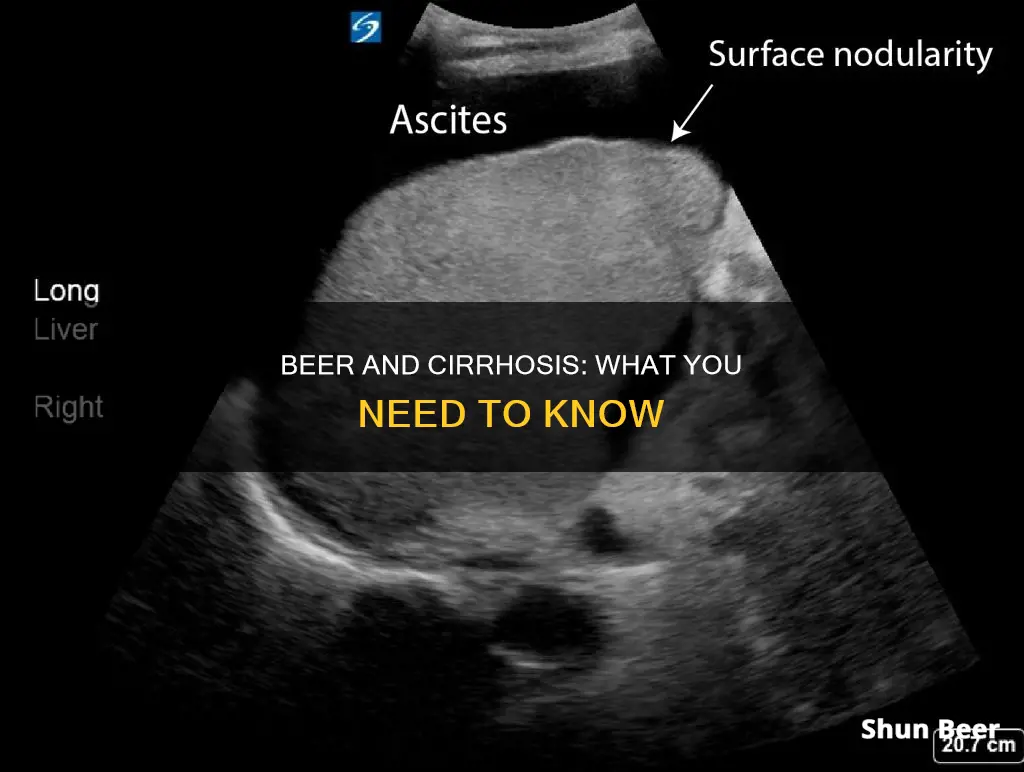
Alcohol-related liver disease is a common but preventable condition. It is caused by heavy alcohol use, which is defined as consuming more than the liver can process. This results in the build-up of fat inside the liver cells, leading to an enlarged liver. In some cases, it can also cause acute inflammation of the liver, followed by permanent scarring and decreased liver function. Alcohol-related liver disease can progress to cirrhosis, which is characterised by the replacement of healthy liver tissue with scar tissue. This scarring is irreversible and can lead to life-threatening complications. Therefore, it is crucial for individuals with cirrhosis to completely abstain from alcohol consumption to prevent further damage to the liver and improve their prognosis.
| Characteristics | Values |
|---|---|
| Can I drink beer with cirrhosis? | No |
| Why? | Alcohol use accelerates liver injury and increases the risk of developing cirrhosis. |
| What is cirrhosis? | A disease of the liver caused by chronic alcohol abuse. |
| What happens when someone gets cirrhosis? | The focus becomes how to preserve liver function. |
| Can the damage caused by cirrhosis be reversed? | No, but it can be slowed or stopped from getting worse. |
| What is the best treatment for cirrhosis? | Stopping drinking alcohol completely. |
| What is heavy alcohol use? | For men, 5 or more drinks on any day or 15 or more drinks per week. For women, 4 or more drinks on any day or 8 or more drinks per week. |
| What is binge drinking? | For women, 4 or more drinks in a single session. For men, 5 or more drinks in a single session. |
| What is the most resilient and vital organ in the human body? | Liver |
What You'll Learn

Cirrhosis is irreversible and caused by chronic alcohol abuse
Cirrhosis is a disease of the liver that is often caused by chronic alcohol abuse. As the liver attempts to repair itself after alcohol abuse, scar tissue forms. Over time, this scarring within the liver can lead to decreased liver function. Once the liver has been damaged by cirrhosis, this damage is irreversible.
The liver breaks down alcohol. If you drink more than it can process, it can become badly damaged. Alcohol-associated cirrhosis is the destruction of normal liver tissue. It leaves scar tissue in place of the working liver tissue. In this situation, the liver may stop working correctly.
The liver is a resilient and vital organ. We can survive on a liver that is only 30% operational; after that, it gets critical. The liver plays a key role in digestion and also produces hormones, bile to digest fats and proteins for blood clotting.
The more alcohol a person drinks, the greater the damage to the liver. When alcohol damages the liver, the liver can continue to function for a while because the liver can sometimes recover from mild damage. Also, the liver can function normally even when about 80% of it is damaged. However, if people continue to drink alcohol, liver damage progresses and may eventually result in death.
About 10% to 20% of people with alcoholic liver disease develop cirrhosis. In cirrhosis, a large amount of normal liver tissue is permanently replaced with scar tissue (called fibrosis), which performs no function. As a result, the internal structure of the liver is disrupted, and the liver can no longer function normally. Eventually, the liver usually shrinks. Cirrhosis usually cannot be reversed.
Cirrhosis can lead to severe complications, including:
- Ascites: Fluid may accumulate in the abdomen, causing swelling.
- Hepatic (portosystemic) encephalopathy: Brain function may deteriorate because the damaged liver is less able to remove toxic waste products from the blood. People may become drowsy and confused.
- Portal hypertension: The vein that brings blood to the liver may be narrowed or blocked, increasing blood pressure in that vein.
- Bleeding in the digestive tract: Veins in the oesophagus and stomach may enlarge and begin to bleed because of portal hypertension. People may vomit blood or have bloody or dark, tarry stools.
- Liver failure: The liver becomes less and less able to function, resulting in many complications and generally failing health. Liver failure can eventually lead to kidney failure.
The best treatment for alcoholic liver disease is to stop drinking alcohol completely. However, this can be very difficult and often requires help, often in rehabilitation programs. Abstinence is the most effective therapy to decrease the risk of further liver damage.
Beer and Low FODMAP Diet: What's the Verdict?
You may want to see also

Alcohol abuse leads to the formation of scar tissue in the liver
Alcohol abuse is a leading cause of liver cirrhosis. The liver is a large organ that sits under the ribs on the right side of the belly. It filters waste from the body, makes bile to aid in food digestion, stores sugar for energy, and makes proteins that work throughout the body, such as those that cause blood to clot.
Alcohol abuse can lead to three types of liver damage:
- Steatotic (fatty) liver: This is the most common alcohol-induced liver problem, caused by a build-up of fat inside liver cells, leading to an enlarged liver.
- Acute hepatitis: Alcohol-associated hepatitis is an acute inflammation of the liver, resulting in liver cell death, often followed by permanent scarring.
- Cirrhosis: Alcohol-associated cirrhosis is the destruction of normal liver tissue, leaving scar tissue in place of functioning liver tissue. This scar tissue disrupts the internal structure of the liver, impairing its ability to function normally. Eventually, the liver shrinks.
The liver can withstand a certain level of alcohol consumption and still recover. However, heavy alcohol use, defined as consuming more than the liver can process, will result in liver damage. The more alcohol a person drinks, the greater the damage to the liver. Over time, this scarring within the liver can lead to decreased liver function.
The formation of scar tissue in the liver, or cirrhosis, is a result of the liver's attempt to repair itself after alcohol abuse. About 10%-20% of chronic heavy drinkers will develop cirrhosis. Once the liver has been damaged by cirrhosis, this damage is irreversible, and any further alcohol consumption will only worsen the condition.
Alcohol abuse increases the risk of developing cirrhosis, and for those with cirrhosis, drinking alcohol can lead to alcoholic hepatitis, which can precipitate acute-on-chronic liver failure with a high mortality rate. Therefore, it is crucial for individuals with liver disease or cirrhosis to completely abstain from alcohol consumption.
Ear Piercing and Beer: What's Safe?
You may want to see also

Abstinence is the only treatment for cirrhosis
Cirrhosis is a disease of the liver. It is often caused by chronic alcohol abuse. As the liver attempts to repair itself after alcohol abuse, scar tissue forms. Over time, this scarring within the liver can lead to decreased liver function. The liver is a large organ that humans cannot live without.
The liver breaks down alcohol. If you drink more than it can process, it can become badly damaged. The more alcohol a person drinks, the greater the damage to the liver. When alcohol damages the liver, the liver can continue to function for a while because it can sometimes recover from mild damage. However, if people continue to drink alcohol, liver damage progresses and may eventually result in death.
The best treatment is to stop drinking alcohol, but doing so is very difficult and requires help, often in rehabilitation programs. Abstinence is the most effective therapy to decrease the risk of further liver damage. Abstinence improves liver function in patients with alcoholic cirrhosis. In patients with alcoholic cirrhosis, continuous alcohol use increases the risk of further decompensation, but sustained abstinence can improve liver function.
Beer and Renal Diet: What You Need to Know
You may want to see also

Cirrhosis can lead to liver cancer
Cirrhosis is a disease in which liver cells become damaged and are replaced by scar tissue. It is the end-stage of every chronic liver disease and is a major risk factor for the development of hepatocellular carcinoma (HCC), the most common form of primary liver cancer.
Cirrhosis may limit surgical and interventional approaches to cancer treatment, influence the pharmacokinetics of anticancer drugs, increase the side effects of chemotherapy, and render patients susceptible to hepatotoxicity. It can also result in a competitive risk for morbidity and mortality.
The exact cause of liver cancer is unknown, but most cases are associated with cirrhosis. Cirrhosis can be caused by heavy and harmful drinking, non-alcoholic fatty liver disease, hepatitis B or C viral infections, haemochromatosis, and primary biliary cirrhosis.
Alcohol is a major risk factor for cirrhosis and liver cancer, with risk increasing exponentially. Women may be at higher risk compared to men even with little alcohol consumption.
Cialis and Beer: Safe Mix or Health Risk?
You may want to see also

Women are at a higher risk of developing cirrhosis
Alcohol is a major risk factor for liver disease in general, and for liver cirrhosis in particular. In fact, about half of the liver cirrhosis burden of morbidity and mortality would disappear in a world without alcohol.
Other biological differences may also contribute to the increased risk for women. While alcohol misuse by anyone is a serious public health concern, women face alcohol-related problems sooner and at lower drinking levels than men. For example, women who drink are at greater risk of developing breast cancer than women who do not consume alcohol.
In addition, women who drink are at a higher risk for liver cirrhosis even with little alcohol consumption. One study found that consuming one drink per day compared to long-term abstinence showed an increased risk for liver cirrhosis in women, but not in men. Drinking five or more drinks per day was associated with a substantially increased risk in both women and men.
The reasons for these sex differences are not yet fully understood. While biology plays a role, with evolutionary explanations pointing to inter-male competition, environmental factors are also important. For example, a recent study found that girls from matrilineal cultures—where women tend to have a higher social status than men—tended to be more risk-taking than girls from more traditional, patriarchal societies.
Beer and Ayurveda: Is It Safe to Drink?
You may want to see also
Frequently asked questions
No, patients with cirrhosis should not drink any alcohol at all. Once the liver has been damaged by cirrhosis, this damage cannot be undone. Any use of alcohol will only damage the liver further.
Cirrhosis is a disease of the liver. It is often caused by chronic alcohol abuse. As the liver attempts to repair itself after alcohol abuse, scar tissue forms. Over time, this scarring within the liver can lead to decreased liver function.
Early on, there are no clear symptoms of a damaged liver. Many people with alcoholic liver damage first become aware of it through basic blood tests. As the liver hardens, more symptoms will begin to emerge. Symptoms include:
- Swelling in legs, ankles, or feet
- Loss of appetite and weight loss
- Bleeding or bruising easily
- Ascites, or fluid in the abdomen
- Disruption in the menstrual cycle for women
- Loss of sex drive for men
- Red palms of the hand
- Yellowed whites of the eyes
- Spider web-like blood vessels in the skin
- Whitened fingernails
- Severe muscle cramping
The most important step to take is to stop drinking alcohol completely. This is because not only will drinking with cirrhosis damage the liver further, but an alcoholic can rarely stop after one drink.







